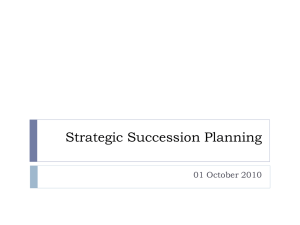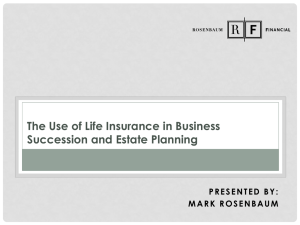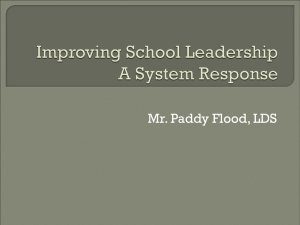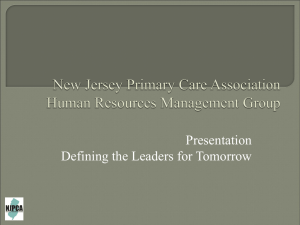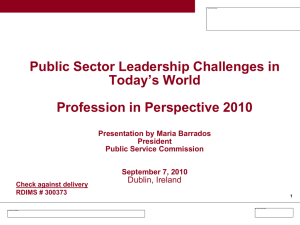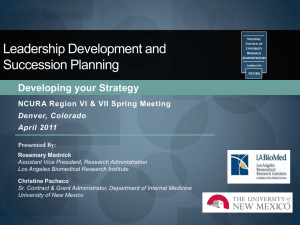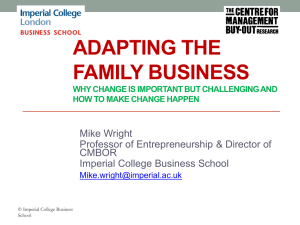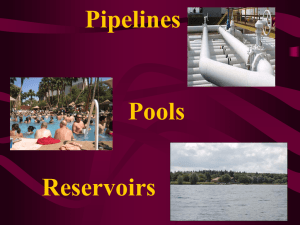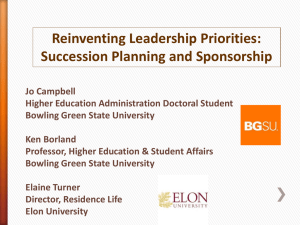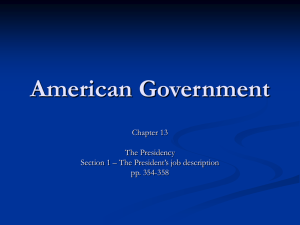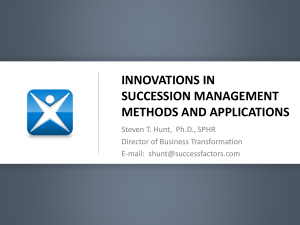Succession Planning
advertisement
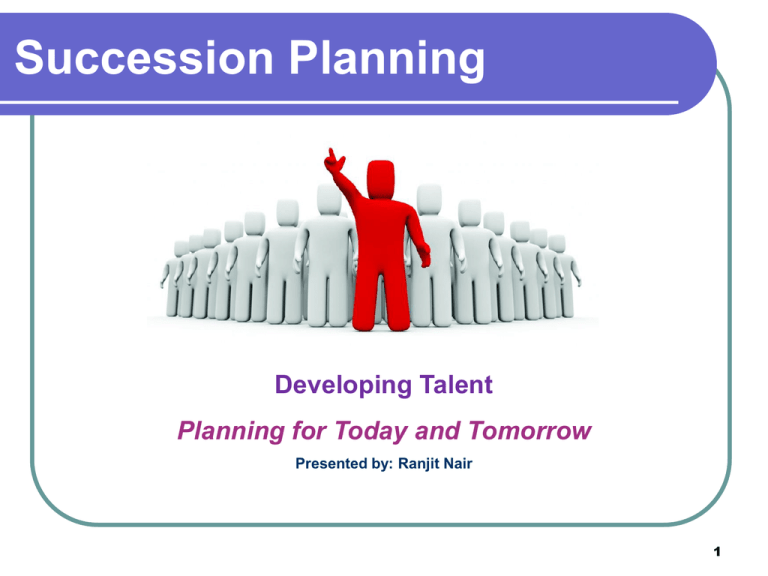
Succession Planning Developing Talent Planning for Today and Tomorrow Presented by: Ranjit Nair 1 What is Succession Planning? Having the right people in the right place at the right time An ongoing process of identifying and developing talent as well as future leaders An opportunity to create standards for qualifications and competencies for future leaders Providing understanding to members of the potential developmental/leadership paths available as well as development needs 2 Why is Succession Planning Important? Building the Talent for the Future Organizational Readiness Developing the Incumbents Assessing Potential Developing Leaders 3 The Drivers Public Schools have become larger, more complex, and more challenging to manage Fragmented staff with different and varying level of skills, experience, backgrounds, functions Heightened focus on student achievement Demand for more scrutiny As school districts increase in size, intricacy, and accountability, they must invest more in the human capital that drives almost all of the services they deliver. 4 Others Perspectives Succession planning goes beyond the basic question of selecting replacements for positions – “Replacement Planning”) Whereas replacement planning finds backups to fill vacancies on an organizational chart, succession planning grooms talent for the future. Succession planning should encompass a dialogue about leadership in the public school district-what characteristics define it, who displays it, who has the potential to display it, and how to transition from the former to the latter. The planning should elicit the opinions of all stakeholders in the district. It should inspire a culture of vision and motivation that aligns with the district's strategic objectives and that infuses the work of all school officials. 5 8 Steps to Effective Succession Planning Be Purpose Driven (1) (Re)Assess Program (8) Develop Individual Plans (7) Plan for Future (2) Succession Planning Assess Current Needs (3) Conduct Effective Assessments (4) Fill in the Gaps (6) Assess Mobility (5) 6 Step 1: Define Purpose Invest in planning and setting the stage. Articulate the purpose, goals, and expectations of succession planning Write a mission statement that captures the urgency of succession planning. Ensure that stakeholder groups, such as the current leadership team are on board Firmly establish expectations about process duration and intensity 7 Step 2: Plan for the Future The succession planning (SP) process should not be designed to address today's organizational challenges, but those of the future – the needs of an evolving organization. SP should be deliberately proactive (growing the district's talent pool.) It should be used a process for reflecting on the district's future. endogenous factors (organizational changes, board priorities, curricular approaches, decentralization, etc.) exogenous factors (demographics, economy, state and federal legislature, etc.) 8 Step 3: Assess Current Leadership Needs Examine the role of leadership in enacting the vision. Assess the characteristics necessary for leadership in the district. Build a "leadership code" that explains leadership characteristics and behaviors that drive success in the district. Certain skills should transcend an organization and unite all of its leaders by using a "leadership code" - a consolidated viewpoint of what matters as leaders progress up the organization. For example, Jim Collins' popular "Good to Great" model traces a progression from capable management, the ability to make productive contributions, through effective leadership, the vigorous pursuit of a clear and compelling vision, and, finally, to enduring executive (Principal; Asst. Principal) greatness. 9 Leadership Hierarchy Level 5 Executive Builds enduring greatness through a paradoxical combination of personal humility plus professional will. Level 4 Effective Leader Catalyzes commitment to and vigorous pursuit of a clear and compelling vision; stimulates the group to high performance standards. Level 3 Competent Manager Organizes people and resources toward the effective and efficient pursuit of predetermined objectives. Level 2 Contributing Team Member Contributes to the achievement of group objectives; works effectively with others in a group setting. Level 1 Highly Capable Individual Makes productive contributions through talent, knowledge, skills, and good work habits. Source: Jim Collins; Good to Great 10 Long term Leadership Hierarchy – What Characteristics Matter in your District? (Sample) Vision, Strategy, Systems Thinking Leaders need to demonstrate these qualities to be effective in our district Short term Ability to Prioritize Ability to allocate resources Process-centric Measurement-focus Brilliant Communicator Gains “Buy-in” Subject Matter Expertise Team Player Good Communicator Customer Service Orientation Proactive Problem Solver Results Oriented Delivers against high expectations 11 Step 4: Conduct Effective Assessments Ensure open and honest feedback about an emerging leader's performance. Without an honest discourse about an individual's strengths and weaknesses, proactive development opportunities cannot be deliberately pursued. A district should evaluate its current and emerging leaders against its leadership code through development and use of a formal evaluation rubric. To provide a relative view of these emerging leaders, districts can evaluate leadership candidates on a matrix that serves as a function of both past performance and future potential. One purpose of such a matrix is to identify the district's "highpotential" leaders, commonly referred to as “HiPo's". 12 Understanding your District’s HIPO Leaders The Performance-Potential Grid Performance HIGH Workhorse or Keepers Stars or Growers Underperformer or Deadwood Question Marks Future Potential LOW HIGH How can we move people between groups? Where do the non-performers fit in the organization? Should they be forced out? Are our resources allocated properly? 13 Understanding your District’s HIPO Leaders The Talent Matrix Doing the Right Things “Diamond in the rough” - Loose Cannon - Problem Child “Future Utility Player” “Future Allround Star” “Future Utility Player” Solid Citizen Solid in Role “Take Action Now” Not developing Not competent No potential In wrong job Move out “Future Pro” Still Developing Not yet exceptional in role Has potential to improve Monitor development “Consistent Star” Fully Developed Excellent in role Need new opportunities “Utility Pro” Fully Competent in Role Still Developing Nearly ready for more responsibility “Technical Pro” Fully competent in role Reached potential Getting the Right Results 14 Step 5: Assess Mobility Further analysis is needed to evaluate the district's "bench strength" and leadership mobility within the organization. Districts should force themselves to complete a deep bench strength analysis, which yields measures concerning the depth of leadership talent within the organization. Compute this measure by listing potential successors for each major position and assigning successors a ranking to denote: Level 1-Successor ready to lead within one year Level 2-Successor ready in one to two years Level 3-No successor ready within a five-year period A Level 3 ranking presents an organizational "hole." The lower the percentage of holes relative to key positions, the greater the organization's bench strength. 15 Step 5: Assess Mobility The basic bench strength measure serves as a foundation on which to calculate several other metrics of an organization's human capital inventory, such as: Average number of candidates "ready now" for key positions Number of vacant key positions Percentage of positions open without "ready now" candidates Total number of high-potential leaders in the succession pool per key position Armed with this data, districts can make targeted investment in readying internal candidates or proactively recruiting external candidates where succession risk is present. 16 Step 6: Fill in the Gaps Each participant in leadership training programs should be the subject of an individualized development plan (an "IDP"). The plan should ask such questions as: For what key position should this person be prepared? What kinds of competencies should be developed? What are the individual's career objectives? What learning objectives should guide the individual's development? By what methods or strategies may the objectives be met? Generally, the most productive lever for leadership development is on-the-job opportunities that widen the scope, increase the depth, and vary the routine of responsibilities. Examples of assignments that satisfy these three areas could take the form of re-launching or revamping a failing service, launching a new service, managing a turnaround situation, handling a rapidly expanding service, preparing a strategic proposal for leadership 17 Step 6: Fill in the Gaps In addition to on-the-job opportunities, organizations may be able to invest in expert leadership coaching and mentoring with good results. Through a "360 degree" evaluation, expert coaches help leaders to understand all their areas of strength and weakness and to grow their emotional intelligence. Best practice coaching structures follow a sequence of enrolling the individual, building a relationship, fact-finding based on existing and new assessment data, collaborating to create a development plan, coaching to the development plan, evaluating the process relative to stated objectives, and planning next steps. 18 Step 7: Develop Individual Transition Plans To facilitate a smooth transition, districts should structure plans that outline the process of orienting new leaders. Transition plans have been used by new superintendents for some time, but enormous variance exists in design and approach Transition plans can be applied to a broad variety of senior leadership positions The product is a results-oriented plan around specific desired outcomes in managerial and organizational performance and district accomplishment. E.g.: “Goals-based” – a new superintendent reads, "Develop a plan to decentralize the organizational structure in order to be more responsive to the needs of principals, schools and the public." “Activities-based approach" - focuses on what the new leader will do, but does little to focus the leader on why they are doing it. 19 Step 8: (Re) Assess the Program Succession planning is a fluid and continual process, subject to regular assessment and adjustment. Evaluation should signify bench strength by measuring the number of well-qualified internal candidates for each key position, the record of promotions, and the retention of high performers. Evaluation should also capture more subjective human capital metrics, including the perceptions of fairness, transparency, morale, confidence, and competence. Ultimately, a successful succession planning program will be a tailored, systematic, and clear process that enjoys dedicated organizational support and that emphasizes long-term leadership development. Best practice is to do a “Succession Planning” immediately after performance evaluations and then conduct a follow-up session to gauge progress against actions generated 20 Circle of Leadership Make Commitment to Leadership Continuity Evaluate & Reward Identify & Develop Individual Talent Assess the Present Assess the Future Needs Establish a Succession Planning Program 21 Succession Planning is a Process The purpose and need for succession planning Timeframe and commitment involved Resources available Vision and mission How it will support the strategic plan of the association 22 Pitfalls to Avoid Lack of leadership Lack of communication Lack of transparency Lack of understanding Making assumptions about future growth Lack of follow up Not institutionalized 23 Mentoring – a Cousin of SP What is it? Structured, trusting relationship What do mentors do? Provide individuals with Support Counsel Friendship Reinforcement Constructive Example Are good listeners who want to help individuals develop 24 Thank you! 25 Ranjit Nair C (512) 497 4331 Emails: rnjnair@yahoo.com leadershipstartshere@gmail.com 26
